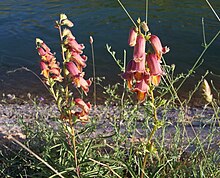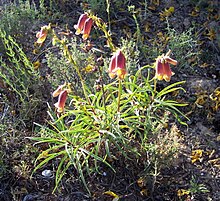Digitalis obscura
This sandbox is in the article namespace. Either move this page into your userspace, or remove the {{User sandbox}} template.
| Digitalis obscura | |
|---|---|

| |
| Digitalis obscura | |
| Scientific classification | |
| Kingdom: | |
| (unranked): | |
| (unranked): | |
| Order: | |
| Family: | |
| Genus: | |
| Species: | obscura
|
| Binomial name | |
| Digitalis obscura | |

The Digitalis obscura is also commonly known as the Sunset Foxglove or Willow-leaved Foxglove. It is a perennial foxglove woody plant belonging to the Plantaginaceae family. It used to be placed in the figwort family, Scrophulariaceae, along with the other foxgloves. The Sunset Foxglove is similar to many of the foxglove species in its uses and toxicity. However, it is known and named after its strikingly distinctive amber to cooper colored flowers.
Distribution and Habitat
Digitalis obscura is native to Spain and northern Africa. It can be grown in many non-native areas as an ornamental plant. The Digitalis obscura grows well in dry climates and in high altitudes such as the mountains in Spain. Unlike many other foxgloves, it is drought tolerant when well rooted. It thrives in average, well-drained soil with pH levels of 5.8-7.2. Wet soil during winter is fatal to the plant. The Digitalis obscura grows in either full or partial sun. It blooms during late spring from May to June and spreads to about 0.75- 1.5 feet. Once established, it is a perennial plant and grows at a rather moderate to fast pace. It is a non-invasive plant and attracts hummingbirds. It is naturally resistant to deer and rabbits. [1]

Morphology
The Digitalis obscura is a shrub that grows about 1-2 feet tall. The stems are smooth and erect. The leaves grow outward along the stem. The thick, glossy leaves are lanceolate shaped with acute tips. The leaves have a blue-green color and a leathery texture. [2]
Flowers
The many flowers of the plant are large, tubular/funnel-shaped and in a pendulous arrangement. They are in clusters on the same side of the floral axis. The flowers are approximately 1.5 inches long and have an appearance of snipped-off fingers as the common name, foxglove, suggests. The sunset foxglove is noted for its rusty dark-orange to green-yellow colored flowers that distinguishes it from the other foxgloves. Inside the flowers, red venation and spotting can also be seen as well as tiny hairs at the tips. The arrangement of the flowers in respect to the stalk is racemes and the flowers droop downward. [3]

Usage
Medicinal
Digitalis obscura like many of the other foxgloves, has been used in pharmaceuticals as a diuretic and to treat heart conditions. It can be used to regulate heartbeats, such as slowing the heart when it is too fast or increasing it when it is too slow. [4]
Even in ethnoveterinary medicine, the stems of the Digitalis obscura was traditionally used for wound healing and toothaches in animals. [5]
Toxicity
All parts of the Digitalis obscura if ingested raw are poisonous, especially the upper leaves. All [Digitalis] are highly toxic if eaten because they contain various cardiac glycosides such as digitoxin, digitalin, digitonin, digitalosmin, gitoxin and gitalonin. During digestion, aglycones and a sugar are produced. Aglycones directly affects heart muscles as it slows the heart rate enough to cause a severe heart attack. The toxins from the Digitalis plants can be used to poison people and have been used for murders and/or suicides in real life and in fictional novels. [6]
References
- ^ "Digitalis obscura". Plant Lust. Retrieved 20 March 2012.
- ^ "Digitalis obscura". Learn 2 Grow. Retrieved 20 March 2012.
- ^ "Digitalis obscura". Missouri Botanical Garden. Retrieved 30 March 2012.
- ^ "Foxgloves". Botanical-Online. Retrieved 2 April 2012.
- ^ Benitez, Guillermo (2011). "Knowledge of ethnoveterinary medicine in the Province of Granada, Andalusia, Spain". Journal of Ethnopharmacology. 139 (2). Retrieved 4 April 2012.
{{cite journal}}: Unknown parameter|coauthors=ignored (|author=suggested) (help) - ^ Robertson, John. "Digitalis spp". Robbo Services Ltd. Retrieved 4 April 2012.
- ^ "Digitalis obscura". Plant Lust. Retrieved 20 March 2012.
- ^ "Digitalis obscura". Learn 2 Grow. Retrieved 20 March 2012.
- ^ "Digitalis obscura". Missouri Botanical Garden. Retrieved 30 March 2012.
- ^ "Foxgloves". Botanical-Online. Retrieved 2 April 2012.
- ^ Benitez, Guillermo (2011). "Knowledge of ethnoveterinary medicine in the Province of Granada, Andalusia, Spain". Journal of Ethnopharmacology. 139 (2). Retrieved 4 April 2012.
{{cite journal}}: Unknown parameter|coauthors=ignored (|author=suggested) (help) - ^ Robertson, John. "Digitalis spp". Robbo Services Ltd. Retrieved 4 April 2012.
